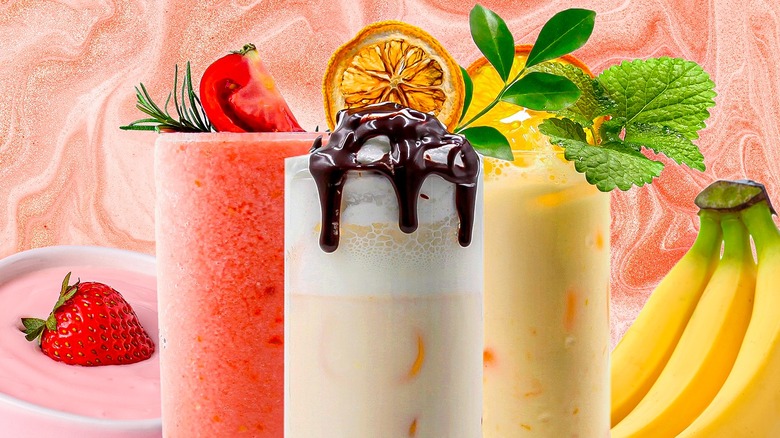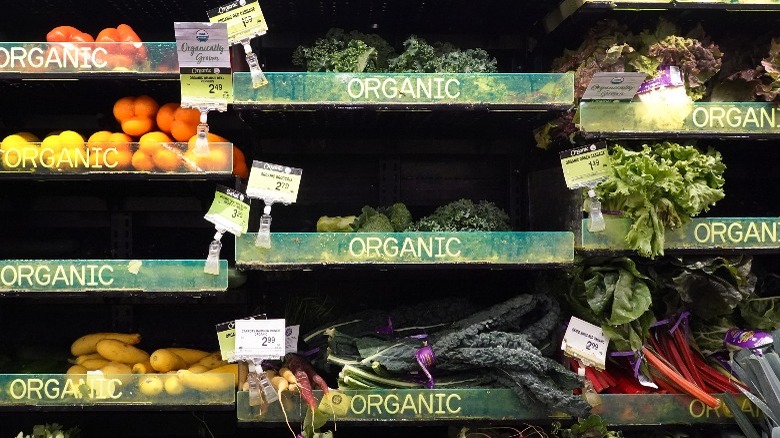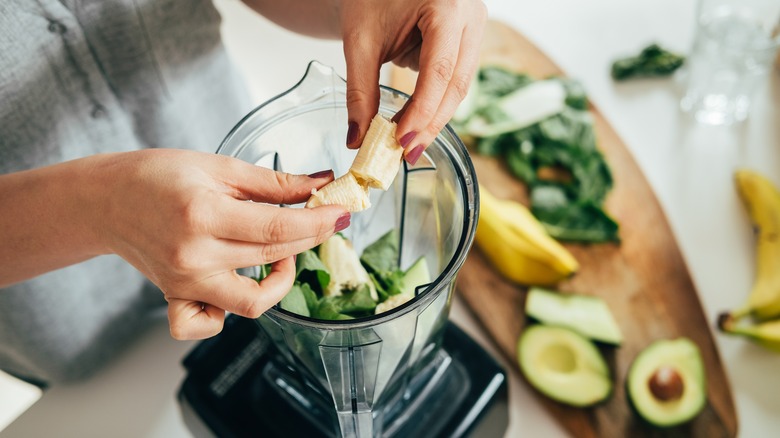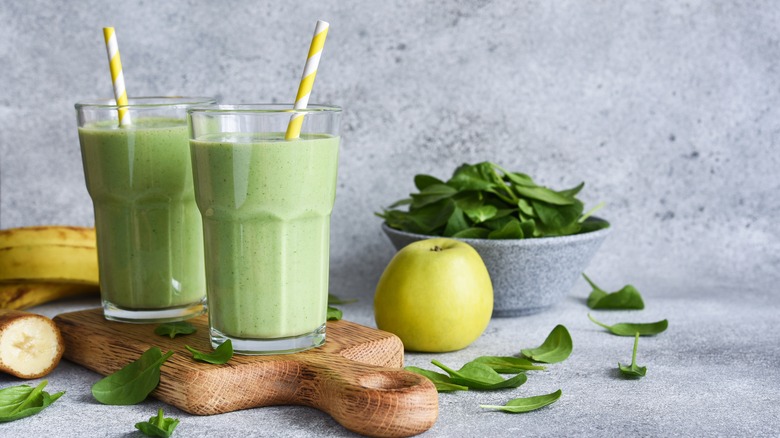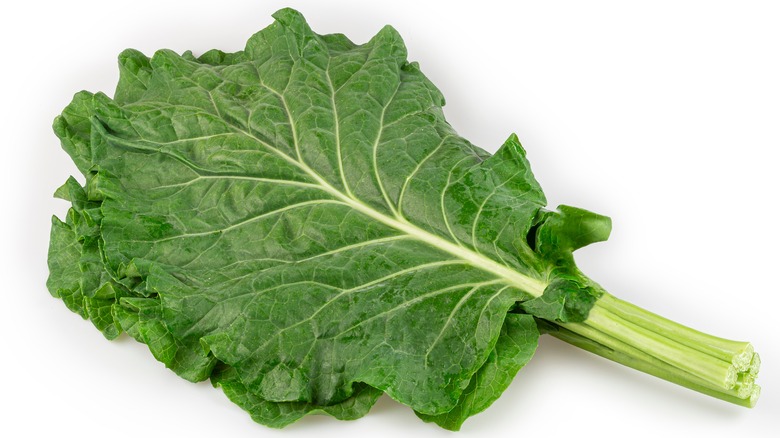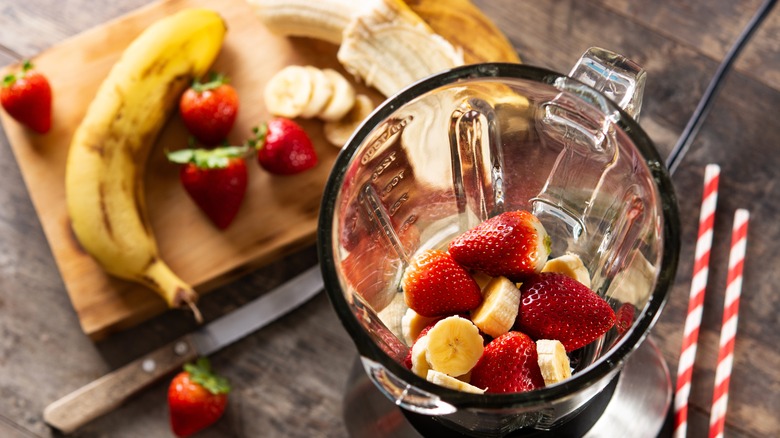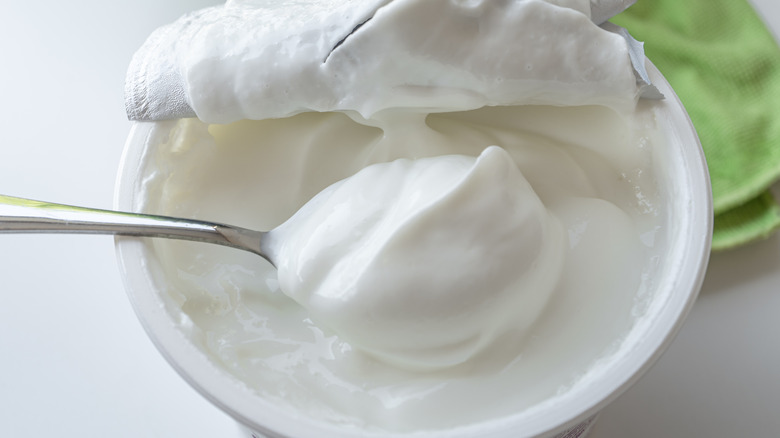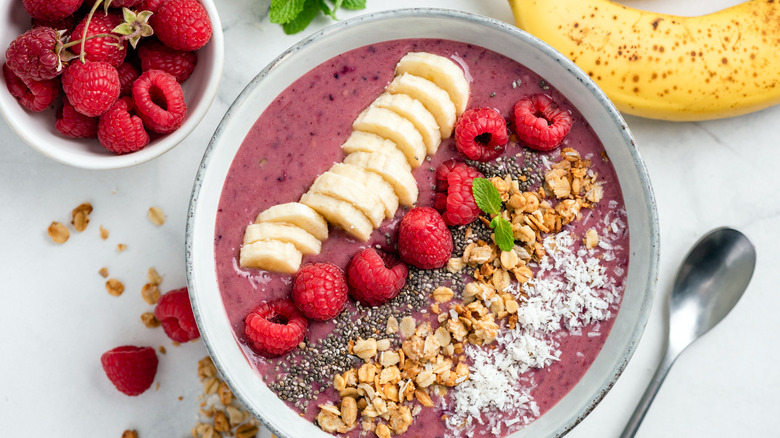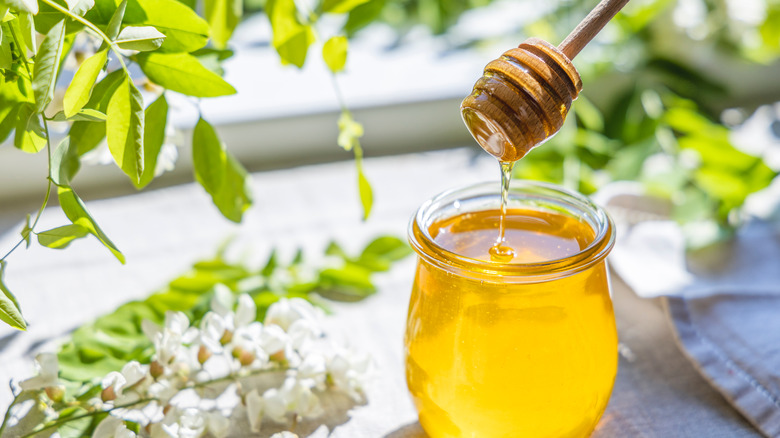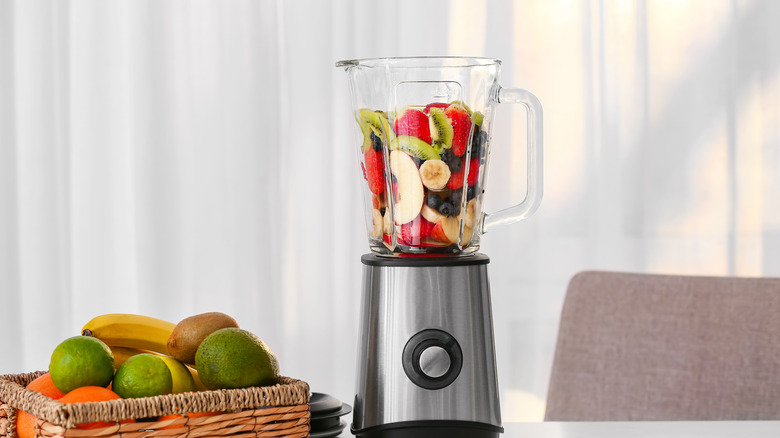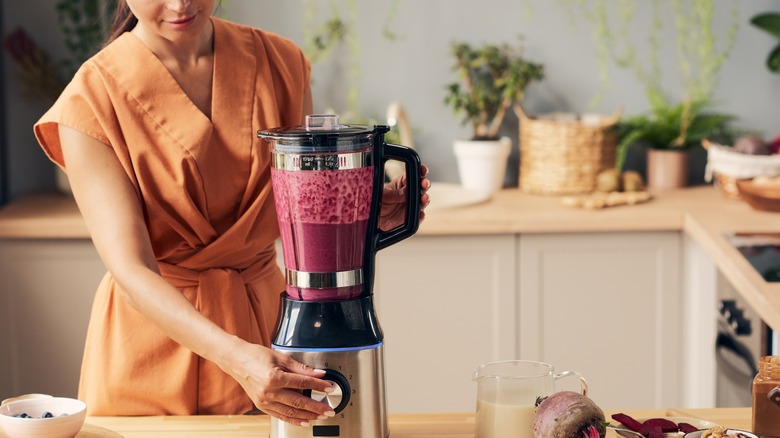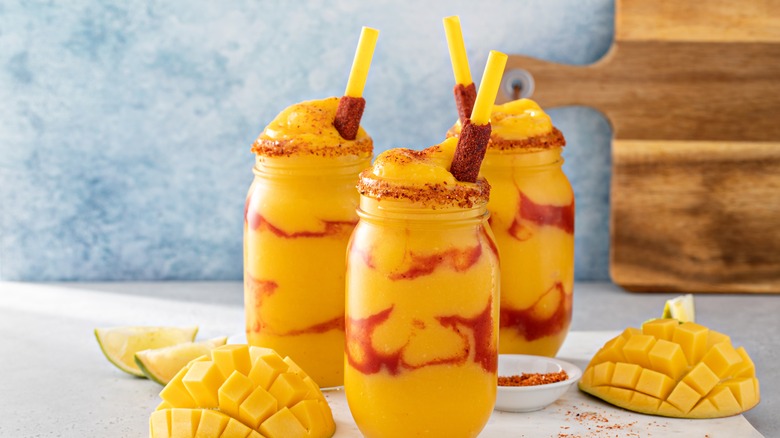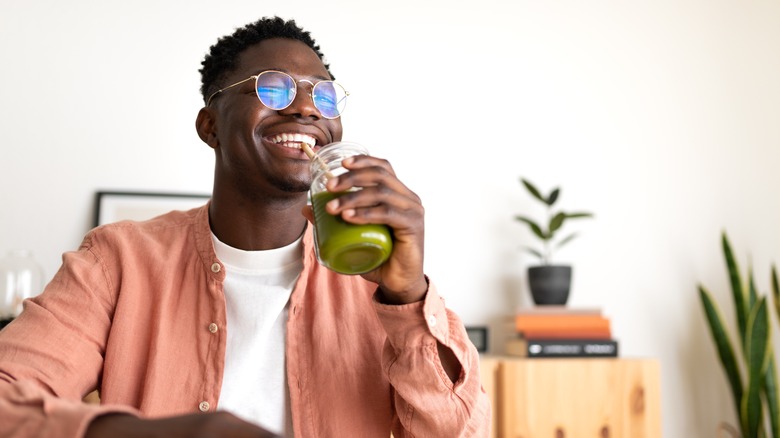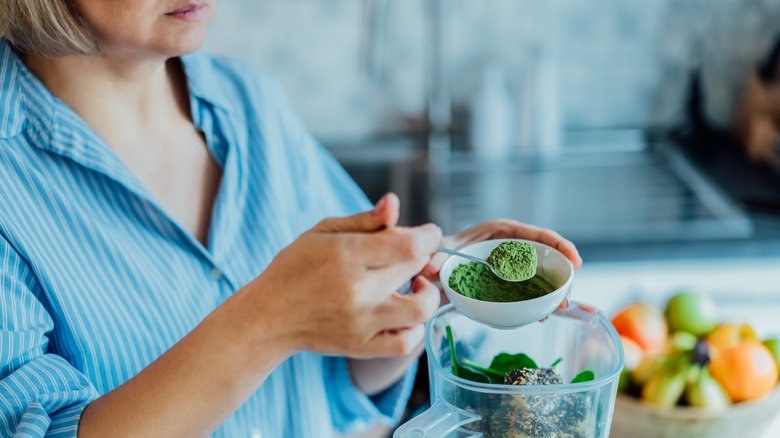14 Ways To Make Your Smoothies Taste Way Better
Smoothies can make a delicious addition to many parts of your day. Whether you're looking to start your morning off right with a healthy green smoothie, want to fuel your body after an intense workout, or simply want to make a sweet treat to enjoy as dessert at the end of the day, making your own smoothie can be a good idea. However, while making a smoothie may seem like a rather basic task, it is not always easy. If you don't get things just right, the texture, flavor, or consistency can be off, leaving you less than happy with what you made.
Fortunately, there are ways to change your smoothie-making routine to ensure that each beverage you blend is better than the last. Continue reading to learn more about choosing the best ingredients to add to your smoothies, following the right ratios, and other important tips to help you achieve the results you're looking for.
1. Use organic fruits and vegetables
If you haven't been using organic fruits and vegetables to make your smoothies, it's time to change that. One of the main reasons many people drink smoothies is to improve their health. However, if you're using whatever fruits and vegetables you stumble across at the grocery store, you're not going to fully be able to achieve this goal.
Conventional produce is grown with pesticides and other chemicals. Even if you rinse your produce off, you won't be able to remove all of these elements. This means that you're introducing potentially harmful chemicals into your smoothie recipes. Some of the chemical pesticides used on conventional produce have even been tied to serious health concerns, such as Parkinson's (via Medical News Today). Spending a few extra dollars to purchase organic produce is worth the peace of mind that you'll feel, knowing that you're doing everything you can to keep yourself — and anyone else you're serving smoothies to – a little bit healthier.
2. Use the right ratio of ingredients
It is also important to add the correct amount of each ingredient. The specific ingredients you'll need will vary, depending on the type of smoothie you're making. But you want to make sure that your finished product is not too thick or too runny.
If you're making a fruit smoothie, the ratio of fruit, liquids, ice, and any other add-ins will vary depending on whether you're using fresh or frozen fruit. When using fresh fruit, use a ratio of about three parts fruit, two parts liquid, two tablespoons of other add-ins, and about three ice cubes. If you're using frozen fruit, skip the ice but then add more liquid.
When making a green smoothie, you'll usually combine fruits, greens, and a liquid. If you're using fresh fruit, use three parts fruit, two parts greens, two parts liquid, and three to four ice cubes. When using frozen fruit, simply leave out the ice and add more liquid.
Of course, different ingredients will blend together differently. You may need to experiment a bit to find the ideal ratio for your favorite recipes. Just remember that it will always be easier to thin down a smoothie — by adding more liquid — than it will be to make it thicker. Always start with less liquid than you think you'll need, and gradually add more if needed.
3. Avoid bitter greens when making green smoothies
Green smoothies are a popular choice because of the health benefits they can offer. However, just because they're healthy, it doesn't mean that they have to taste worse. When developing or following recipes to make a green smoothie, stay away from bitter greens, such as broccoli rabe, mustard greens, or dandelion greens. Adding these to your green smoothie can make it too intensely bitter or sharp.
You can still reap health benefits from greens in your smoothie by adding milder ones. A few good options to consider are beet greens, spinach, kale, and Swiss chard. Another option is to add other vegetables instead of, or in addition to, the greens. Try puréed pumpkin, baked sweet potatoes, or cooked beets.
If you've already made a smoothie with one of the more bitter greens, there is something you can do to help it taste better. Mix in about one teaspoon of vanilla extract. Its flavor will help cover up the harsh taste of the bitter greens you used.
4. Don't use the ribs from larger leaves
If you're making pear smoothies with kale, or following another recipe that calls for larger leaves, leave out any thicker ribs. Ribs are the thick stems that run through the center of vegetables such as collard greens. While edible, these thicker ribs will make your smooth taste stringy. Your blender won't fully break the ribs down, leaving strings mixed throughout the smoothie. Sucking these strings through the straw will obviously make drinking the smoothie less enjoyable.
Similarly, if you want to avoid stringy smoothies, make sure to completely grind down your ginger root. Fresh ginger is difficult for many blenders to thoroughly pulverize. If you've made these changes and your smoothies are still turning out stringy, it might be time to buy a more powerful blender. If the blender itself doesn't have enough power, the blades aren't going to be able to break down all the ingredients as well.
5. Add frozen bananas for an improved texture
If you haven't been happy with the texture of your smoothies, try adding frozen bananas. These icy fruits will help even out the texture, making your creation smoother, and thus more enjoyable. While you may be able to pick up a bag of frozen bananas at the grocery store, it will be less expensive to make your own. Even better, it doesn't require much time or effort, so you can still get on to everything else on your to-do list.
Wait to freeze your bananas until they are ripe. They will not continue to ripen in the freezer. After your bananas have ripened, peel and slice them into pieces that are about half an inch thick. Lay the banana slices onto a parchment-lined baking sheet, and place them in the freezer for about half an hour. Once the bananas are frozen, transfer them from the parchment paper to a freezer-safe bag. Press out all of the air, and put the bag in the freezer. The next time you want to make a smoothie, remove a few banana slices from the bag and toss them into your blender.
6. Use yogurt
Adding yogurt can help improve the way your smoothies taste. It makes them thick, creamy, and utterly divine. Some people want to add milk for a creamier taste, but adding too much milk will only thin the smoothie out and make it runny. Yogurt can help you achieve that same flavor, without making the smoothie too thin. Another benefit is that yogurt can also increase the amount of protein in the smoothie. With higher protein levels, the smoothie will be more filling, helping to curb cravings and reduce snacking.
However, the type of yogurt you add to your smoothie matters. If you add yogurt with a high sugar or fat content, that healthy smoothie can quickly become less healthy. Instead, consider using Greek yogurt. Not only is it very high in protein — there are about 20 grams in every 7 ounces — but it also has live probiotics to help keep your gut healthy, according to Healthline.
7. Try making a smoothie bowl
The next time you're thinking about making a smoothie, consider changing things up a bit and making a smoothie bowl instead. Smoothie bowls are pretty much what they sound like: a smoothie you eat out of a bowl using a spoon, rather than drinking it out of a cup using a straw. However, because of the difference in how they are eaten, smoothie bowls open up more possibilities when it comes to preparation. You don't have to worry as much about making the smoothie too thick to drink from a straw.
Making a thicker blend of ingredients is one of the benefits of smoothie bowls. You can make these creations more nutrient-dense, adding ingredients that you'd have to leave out if you were planning to drink them through a straw. You can also top the smoothie with other healthy foods, such as nuts, granola, seeds, or fresh fruit, to make it more satisfying and healthy. With the right additions, a smoothie bowl can make a satisfying meal.
8. Sweeten it up with some honey
If your smoothies are tasting too bitter or acidic, adding a sweetener can help. Honey is a natural sweetener. Adding it to your smoothies over sugar is preferred, as honey has a lower glycemic effect than sugar. This means it won't spike your blood sugar as quickly or dramatically, per Verywell Health. Honey also contains greater nutritional benefits. Adding it to your smoothie can help provide your body with small amounts of iron, zinc, and potassium (via WebMD).
Honey does still add calories and sugar to your smoothies, so you'll want to use it sparingly. Before you add it to a smoothie, take a taste to make sure it is even needed. Fruit is naturally sweet, so depending on the ratio of fruit to greens in your drink, you might not even need an additional sweetener. If you do need to sweeten it up, it won't take much. Just one or two teaspoons of honey should suffice.
9. Add ingredients to the blender cup in the right order
Because all smoothie ingredients eventually get combined, you might assume that it doesn't matter how they are added to the blender. But the order matters. If you simply toss everything in the blender without thinking about this, the resulting smoothie could turn out chunky or stringy. It could even jam up the blades, stopping them from turning properly.
You want to layer your smoothie with heavier stuff at the bottom and the liquids at the top. This creates a vortex, sucking the heavier items down into the blades where they'll be finely blended.
On the other hand, many people have personal smoothie cup attachments for their blenders. If you're using one of these, you will want to layer the ingredients in the opposite order. This is because you'll need to flip the cup upside down to put it on the blender, so everything will end up in reverse order from how you loaded it.
10. Choose the right blender speeds
You also can't just choose any blender speed setting and expect your smoothie to turn out smooth and creamy. Even with the liquid on the bottom of the blender, the blades are still going to have to do some serious work to blend up the harder chunks of fruits and vegetables you're using. Plus, if you start the blender at too high of a speed, it could end up burning out the motor.
The best thing to do is to start at a slower speed. Use a lower speed until the blades have cut through some of the larger chunks, and everything is moving more easily. Be sure to also use the tamper — that may have come with your blender — to press larger pieces of fruits and vegetables down into the base of the blender. This allows them to get chopped up quicker.
Before turning the blender off, ramp up the speed for the final few 20 seconds. This will help ensure that everything is nicely smoothed out. Based on how the mixture is moving around, you should also be able to tell if the smoothie needs some additional liquid (to thin it out) or ice (to thicken it up a bit).
11. Focus on presentation
The way something looks usually impacts how it tastes. Our brains take visual appearance into account when forming good or bad food opinions. Whether you're making a green smoothie or a tropical fruit smoothie, taking a few extra minutes to make it pretty can actually make it more enjoyable.
There are a few different ways to achieve this goal. The first is to choose the right type of cup or glass to serve the smoothie in. Instead of a stainless steel tumbler or plastic cup, use a glass container. When you're able to see through the glass and look at the brighter color of the smoothie, it can make it look more attractive to your brain.
After filling your glass with the smoothie, take an extra minute to sprinkle the top of the drink with seeds, coconut flakes, or other embellishments. You could even put an orange slice, a piece of pineapple, or a strawberry on the rim of the cup to pull the whole look together. Once your smoothie is Instagram-ready, you can sit down to enjoy it — or take a few pictures first.
12. Drink it right away
Smoothies are best when enjoyed immediately after they're blended. If the smoothie sits out for too long, the ice will start to melt, causing the ingredients to separate. If this happens, the taste and texture will be off. The smoothie will be too runny. To some smoothie drinkers, this makes the beverage not enjoyable at all. If you think putting your smoothie in the refrigerator will be sufficient to maintain the slushy, frozen texture, think again. Doing so will actually cause the drink to melt and separate.
The best thing to do is to let yourself sit down and enjoy your smoothie right away. Don't make a smoothie if you have other things you want to get done. Wait to blend the ingredients until you know you'll be able to take a few minutes for yourself to sit and enjoy your concoction.
As a tip, once you've finished drinking the smoothie, take a few minutes to clean the blender. Letting it sit untouched for several hours is just going to leave you with a sticky mess. If you don't have time to fully clean it, at least give the blender a quick rinse to remove the excess smoothie pieces left inside of it.
13. Experiment with new recipes
If you're still looking for some more ways to make your smoothies taste better, consider branching out and trying some new recipes. We can all get stuck in a rut with the ingredients we add to our smoothies. Whether they're what you've always used, what you seem to have on hand most days, or what's easiest to store, using the same ingredients time after time can get boring. Even if you love the way the smoothie tastes, your taste buds may start craving a change.
Now is the perfect time to research a few new smoothie recipes, perhaps with some ingredients you haven't tried before. Give them a shot and see what you think. You never know, you could find a few new favorites to work into the rotation. A few ideas you could try include a coconut pumpkin smoothie, a pineapple kale smoothie, a peach-ginger banana smoothie, a strawberry kiwi smoothie, or a papaya and mango smoothie.
